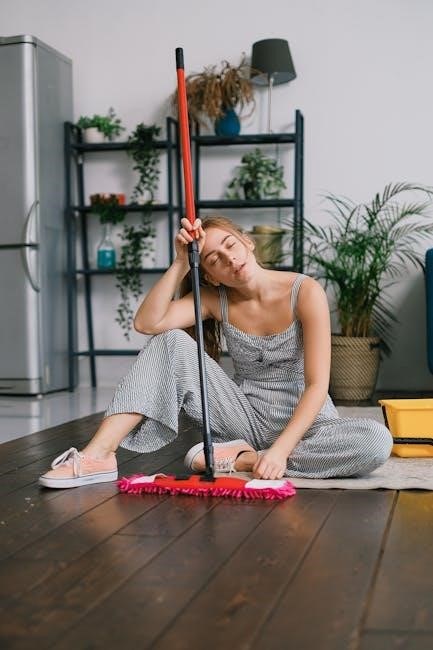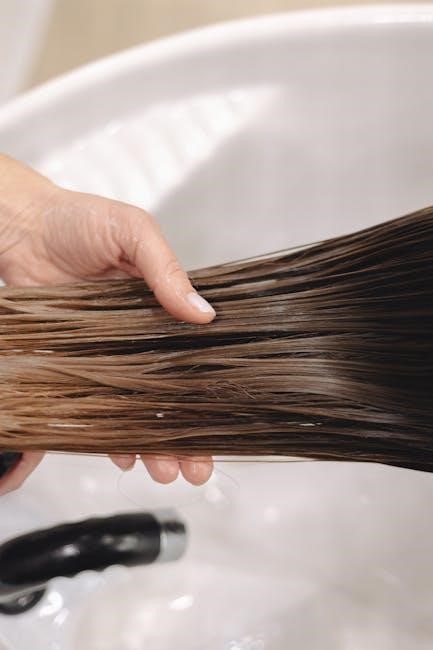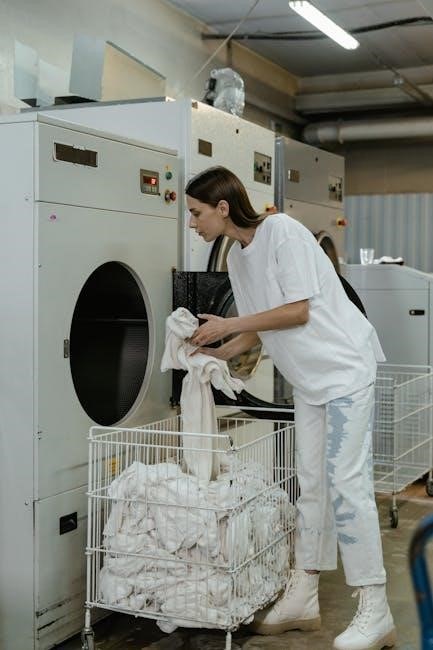Training Manual Overview
This cleaning service training manual is designed to provide internal training materials and guidance for trainers․ It ensures high cleanliness and safety standards․ It covers essential protocols and practices required in commercial cleaning environments․ We aim to provide the highest quality service our clients need․
Purpose of the Manual
The primary purpose of this manual is to serve as a comprehensive guide for cleaning personnel, providing step-by-step instructions on maintaining cleanliness and hygiene in various settings․ It aims to standardize cleaning procedures, ensuring consistency and efficiency across all tasks․ This manual outlines the essential protocols required to maintain high standards of cleanliness and safety․ It also introduces green cleaning practices, focusing on environmentally friendly products and methods․
Furthermore, it serves as a training tool for new employees, equipping them with the knowledge and skills necessary to perform their duties effectively․ It addresses various cleaning techniques, including dusting, washing, sweeping, mopping, and vacuuming, ensuring that every aspect of cleaning is covered․ The manual also emphasizes the importance of identifying and reporting lost property, maintaining professional standards․ This ensures that cleaning staff understands their role in upholding the company’s reputation․ Ultimately, this manual aims to elevate the quality of cleaning services provided․
Target Audience
This training manual is specifically designed for individuals involved in the provision of cleaning services, encompassing both new recruits and experienced professionals․ It is intended for cleaning staff working in diverse environments, including residential, commercial, and industrial settings․ The manual caters to those seeking to enhance their understanding of cleaning techniques, protocols, and best practices․ It also targets internal trainers responsible for delivering training programs within cleaning organizations․
Supervisors and managers overseeing cleaning operations will also find this manual beneficial․ It provides them with a standardized framework for training and evaluating their teams․ The content is structured to be accessible and easily understandable, regardless of prior experience or educational background․ Individuals interested in learning about green cleaning methods and sustainable practices will also find value in this manual․ It serves as a valuable resource for anyone committed to maintaining high standards of cleanliness and hygiene in their respective roles․ This manual supports both individual development and organizational effectiveness․

Core Cleaning Procedures
This section details essential janitorial cleaning processes․ It includes dusting, washing, sweeping, mopping, and vacuuming․ These procedures maintain high standards of cleanliness․ The manual offers step-by-step guidance․ It is based on 20 years of practical experience․ The methods suit individuals and businesses․
Dusting Techniques
Effective dusting is crucial for maintaining a clean environment․ Begin by gathering your supplies: microfiber cloths, dusting spray (if needed), and a duster with an extendable handle for high or hard-to-reach areas․ Always start dusting from the top down to prevent re-dusting lower surfaces․
For shelves and flat surfaces, use a slightly damp microfiber cloth․ The dampness helps trap dust rather than just moving it around․ Wipe in a systematic manner, overlapping each stroke to ensure complete coverage․ Pay attention to edges and corners where dust tends to accumulate․
For delicate items or surfaces, use a soft duster or a dry microfiber cloth․ Gently dust these items, taking care not to scratch or damage them․ For intricate items, consider using a small brush to reach into crevices․
When dusting electronics, always turn them off first․ Use a dry microfiber cloth to wipe the screens and surfaces; Avoid using liquids directly on electronics․ Regularly clean your dusting cloths to maintain their effectiveness and prevent spreading dust․
Washing Methods
Proper washing techniques are essential for removing dirt, grime, and bacteria from various surfaces․ This section outlines the correct procedures for different materials and areas․ Always start by gathering necessary supplies: appropriate cleaning solutions, sponges, microfiber cloths, and buckets․ Ensure you have proper ventilation before beginning any washing task․
For general surface washing, prepare a solution of warm water and a mild detergent․ Use a sponge or microfiber cloth to apply the solution to the surface, working in small sections․ Scrub gently to remove dirt and stains․ Rinse the surface thoroughly with clean water to remove any soap residue․ Dry the surface with a clean, dry cloth to prevent water spots․
When washing windows and mirrors, use a specialized glass cleaner․ Spray the cleaner onto the surface and wipe with a clean, lint-free cloth or paper towel․ Use overlapping strokes to avoid streaks․ For heavily soiled windows, pre-wash with soapy water before applying the glass cleaner․
For floors, select a cleaning solution appropriate for the flooring material․ Follow the manufacturer’s instructions for dilution and application․ Mop the floor in overlapping strokes, rinsing the mop frequently․ Allow the floor to air dry or use a clean, dry mop to speed up the drying process․
Sweeping and Mopping
Sweeping and mopping are fundamental cleaning tasks crucial for maintaining clean and hygienic floors․ This section details the correct methods for sweeping and mopping different floor types․ Before mopping, always sweep or vacuum the floor to remove loose dirt, debris, and dust․ This prevents spreading dirt during the mopping process․
For sweeping, use a broom with sturdy bristles suitable for the floor surface․ Start at one end of the room and sweep towards the center, collecting debris in a dustpan․ Overlap each stroke to ensure all dirt is captured․ Dispose of the collected debris properly․
For mopping, select a mop and cleaning solution appropriate for the floor type․ Prepare the cleaning solution according to the manufacturer’s instructions․ Dip the mop into the solution, wring out excess liquid, and mop the floor in overlapping strokes․ Rinse the mop frequently in a separate bucket of clean water to prevent reintroducing dirt to the floor․
When mopping, pay attention to corners and edges, as these areas tend to accumulate dirt․ Use a clean, dry mop or cloth to dry any remaining moisture on the floor․ Allow the floor to air dry completely before allowing traffic․
Vacuuming Procedures
Vacuuming is an essential cleaning procedure for removing dust, dirt, and debris from carpets, rugs, and hard floors․ Proper vacuuming not only improves cleanliness but also extends the life of flooring materials․ Before starting, ensure the vacuum cleaner is in good working condition with a clean filter and an empty bag or canister․ Select the appropriate vacuum head attachment for the floor type being cleaned․
For carpets and rugs, use a vacuum with a beater bar or rotating brush to loosen embedded dirt․ Move the vacuum in overlapping strokes, covering the entire surface․ Pay extra attention to high-traffic areas and edges․ Empty the vacuum bag or canister regularly to maintain optimal suction․
For hard floors, use a vacuum with a hard floor attachment or switch to the bare floor setting․ This prevents scratching or damaging the floor surface․ Vacuum in smooth, overlapping strokes, ensuring all dirt and debris are removed․ Use a crevice tool to reach tight spaces and corners․
Regular vacuuming is crucial for maintaining a clean and healthy environment․ Frequency depends on the amount of traffic and the type of flooring․ Vacuum high-traffic areas daily and less frequently used areas at least once a week․

Green Cleaning Practices
This section introduces green cleaning, covering products and application․ Green cleaning prioritizes environmentally friendly methods․ Our responsibility includes sustainable practices, minimizing harm․ Basics of green cleaning will be discussed․ Cleaning tips and methods are available․ Green cleaning maintains cleanliness and safety standards․
Green cleaning prioritizes environmentally friendly products and methods; This section introduces the basics of green cleaning, emphasizing sustainable practices․ Understanding these products is crucial for maintaining cleanliness while minimizing environmental impact․ Green cleaning is more than a trend; it’s a responsibility․ Our commitment to using green products reflects our dedication to both clients and the planet․
Green cleaning products avoid harsh chemicals, ensuring a safer environment for both cleaning staff and building occupants․ Many traditional cleaning products contain substances that can contribute to health problems․ Green alternatives are designed to be biodegradable and less toxic․ This reduces the risk of allergic reactions and respiratory issues․
Choosing green cleaning products also supports companies committed to sustainability․ These companies often prioritize eco-friendly packaging and ethical sourcing․ It’s important to look for certifications that verify a product’s green claims․ By selecting these products, we contribute to a healthier and more sustainable future․ This improves indoor air quality and reduces pollution․
Application of Green Cleaning Methods
Applying green cleaning methods involves more than just using eco-friendly products; it requires a comprehensive understanding of how to maximize their effectiveness while minimizing waste․ This section focuses on practical techniques for implementing green cleaning strategies in various settings․ Green cleaning methods are not only environmentally responsible but often more efficient in the long run․
One key aspect is proper dilution․ Using the correct amount of product, as indicated on the label, is essential to avoid unnecessary waste and ensure optimal cleaning performance․ Microfiber cloths are also vital․ These cloths are reusable and highly effective at trapping dirt and grime․ They reduce the need for paper towels and disposable wipes․
Another important method is the strategic use of cleaning solutions․ Focusing on areas that require the most attention can prevent over-cleaning and conserve resources․ Regular maintenance and preventative measures can also reduce the need for harsh chemicals․ By integrating these methods, we can maintain a clean and healthy environment in a sustainable way․ This approach aligns with our mission to protect both people and the planet․

Additional Cleaning Tasks
Beyond the core cleaning procedures, several additional tasks enhance the overall cleanliness and appearance of a space․ These include buffing techniques for floors, specific methods for dusting, and special finishing touches․ Mastering these tasks elevates our service quality․
Buffing Techniques
Buffing is a specialized cleaning task that enhances the shine and appearance of hard floors, primarily those made of wood, tile, or linoleum․ Proper buffing removes minor scratches, scuffs, and embedded dirt, restoring the floor’s original luster․ This section outlines essential buffing techniques for achieving professional results․
Before commencing, ensure the floor is thoroughly cleaned and dry․ Remove any loose debris through sweeping or vacuuming․ Select the appropriate buffing pad based on the floor type and desired outcome․ A coarse pad is suitable for removing heavier imperfections, while a finer pad polishes the surface to a high gloss․
Apply a thin, even layer of floor finish or polish using a mop or applicator․ Allow the finish to dry completely according to the manufacturer’s instructions․ Attach the selected buffing pad to the buffing machine and operate it at a consistent speed, overlapping each pass to ensure uniform coverage․ Avoid excessive pressure, which can damage the floor or leave swirl marks․ After buffing, dust the floor with a microfiber cloth to remove any remaining residue․
Finishing Touches
The final impression left on a space is often determined by the attention to detail in the finishing touches․ After completing the core cleaning procedures, these additional steps elevate the overall cleanliness and create a welcoming environment․
Firstly, ensure all surfaces are free of streaks and smudges․ Use a clean, dry microfiber cloth to wipe down mirrors, glass surfaces, and stainless steel appliances․ Pay particular attention to fingerprints and watermarks․ Next, straighten and arrange furniture, cushions, and decorative items to create a neat and organized appearance․ Align rugs and mats to ensure they are evenly spaced and free of wrinkles․
Empty all trash receptacles and replace liners․ Ensure the receptacles themselves are clean and odor-free․ In restrooms, replenish soap dispensers, paper towels, and toilet paper․ Finally, conduct a final walkthrough of the space, paying attention to lighting and ventilation․ Open windows to air out the room, or adjust the thermostat to a comfortable temperature․ A pleasant fragrance can be added with a subtle air freshener, completing the finishing touches․

Important Protocols
Maintaining safety and security are paramount․ This section details crucial protocols for handling various situations․ It includes procedures for lost property, chemical spills, and emergency scenarios․ Adherence ensures a safe environment․ Proper reporting and documentation are key to successful implementation․
Lost Property Procedures
The handling of lost property is a critical aspect of maintaining client trust and upholding our company’s integrity․ Upon discovering any item that appears to be lost or misplaced, employees must adhere to the following procedures meticulously․ First and foremost, do not, under any circumstances, keep the item․ Immediate reporting is crucial․ Carefully document the item’s description, location, and the date and time it was found․
This information should be immediately reported to the designated office or supervisor․ Secure the item in a safe and designated “Lost and Found” area, preventing any potential damage or loss․ Maintain a detailed log of all reported items, including the date of discovery, description, location, and the name of the employee who found it․
Regularly check the “Lost and Found” log against any inquiries from clients․ If a match is found, follow company protocol for returning the item, ensuring proper identification and documentation of the return․ These procedures are important for maintaining client trust and satisfaction․

